Cold Mix Asphalt: Properties, Performance, and Relevant Studies
VerifiedAdded on 2020/06/06
|19
|6097
|319
Report
AI Summary
This report provides a comprehensive overview of cold mix asphalt, beginning with background information on asphalt materials and their applications in road construction. It details the different types of asphalt, including hot, warm, and cold mixes, and discusses the mechanical and surface properties crucial for pavement design and performance. The report explores mechanical properties such as stiffness, fatigue resistance, and resistance to permanent deformation, along with surface properties like skid resistance and texture. It also delves into asphalt deterioration, its causes, and the influence of water pressure on various surfacing types. Furthermore, the report reviews relevant studies on friction, texture, and long-term performance, providing a detailed analysis of the factors affecting asphalt pavement durability and functionality. The report includes tables, illustrations, and formulas to support the analysis.
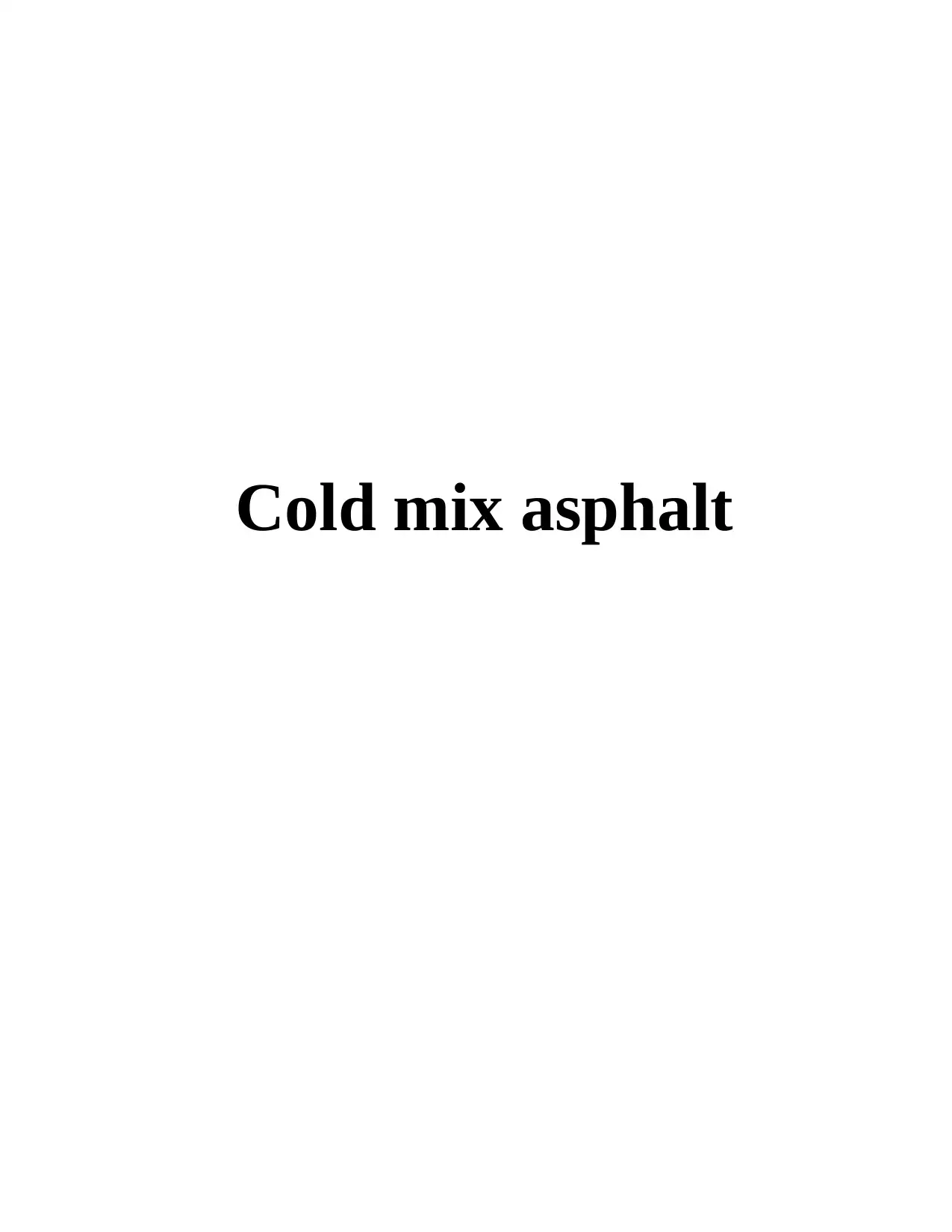
Cold mix asphalt
Paraphrase This Document
Need a fresh take? Get an instant paraphrase of this document with our AI Paraphraser
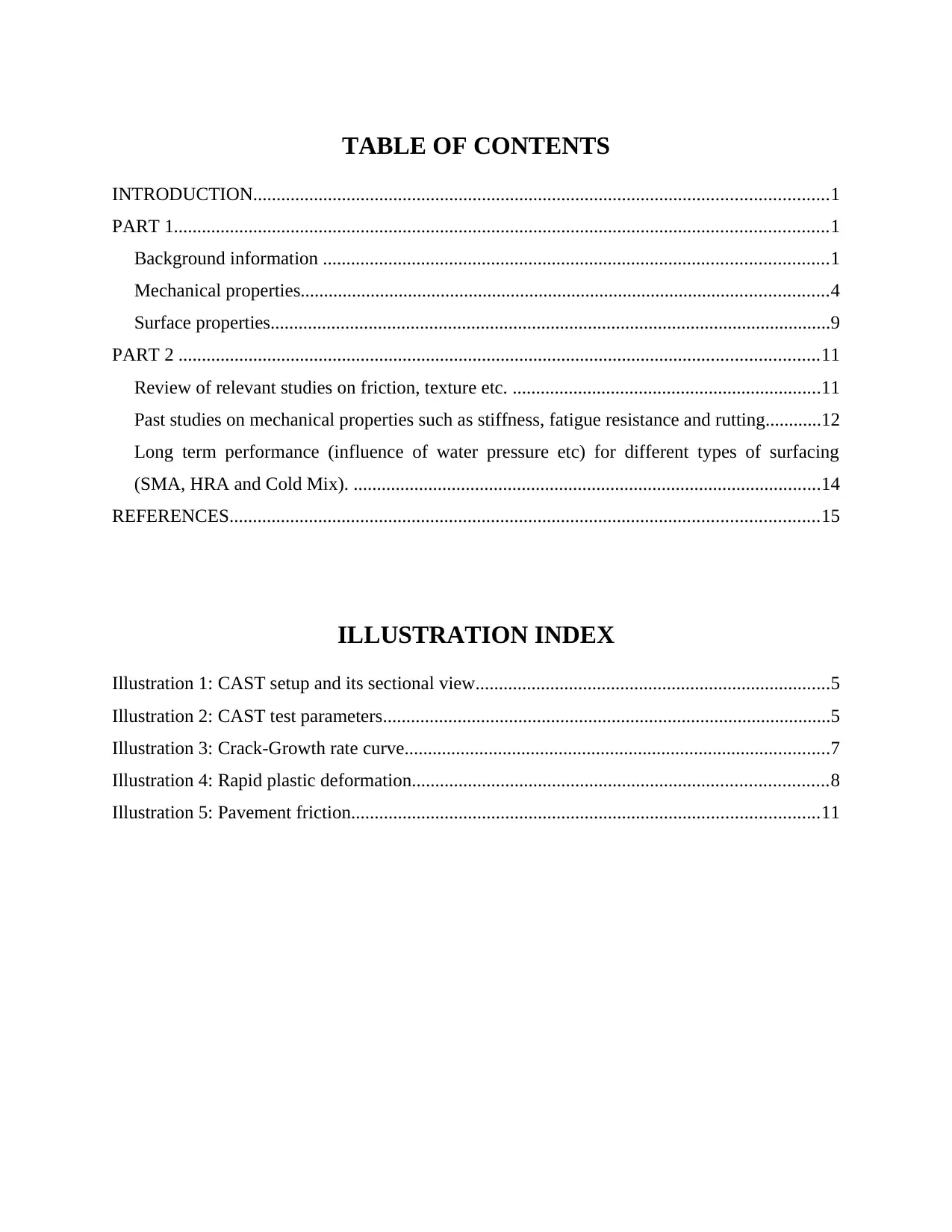
TABLE OF CONTENTS
INTRODUCTION...........................................................................................................................1
PART 1............................................................................................................................................1
Background information ............................................................................................................1
Mechanical properties.................................................................................................................4
Surface properties........................................................................................................................9
PART 2 .........................................................................................................................................11
Review of relevant studies on friction, texture etc. ..................................................................11
Past studies on mechanical properties such as stiffness, fatigue resistance and rutting............12
Long term performance (influence of water pressure etc) for different types of surfacing
(SMA, HRA and Cold Mix). ....................................................................................................14
REFERENCES..............................................................................................................................15
ILLUSTRATION INDEX
Illustration 1: CAST setup and its sectional view............................................................................5
Illustration 2: CAST test parameters................................................................................................5
Illustration 3: Crack-Growth rate curve...........................................................................................7
Illustration 4: Rapid plastic deformation.........................................................................................8
Illustration 5: Pavement friction....................................................................................................11
INTRODUCTION...........................................................................................................................1
PART 1............................................................................................................................................1
Background information ............................................................................................................1
Mechanical properties.................................................................................................................4
Surface properties........................................................................................................................9
PART 2 .........................................................................................................................................11
Review of relevant studies on friction, texture etc. ..................................................................11
Past studies on mechanical properties such as stiffness, fatigue resistance and rutting............12
Long term performance (influence of water pressure etc) for different types of surfacing
(SMA, HRA and Cold Mix). ....................................................................................................14
REFERENCES..............................................................................................................................15
ILLUSTRATION INDEX
Illustration 1: CAST setup and its sectional view............................................................................5
Illustration 2: CAST test parameters................................................................................................5
Illustration 3: Crack-Growth rate curve...........................................................................................7
Illustration 4: Rapid plastic deformation.........................................................................................8
Illustration 5: Pavement friction....................................................................................................11
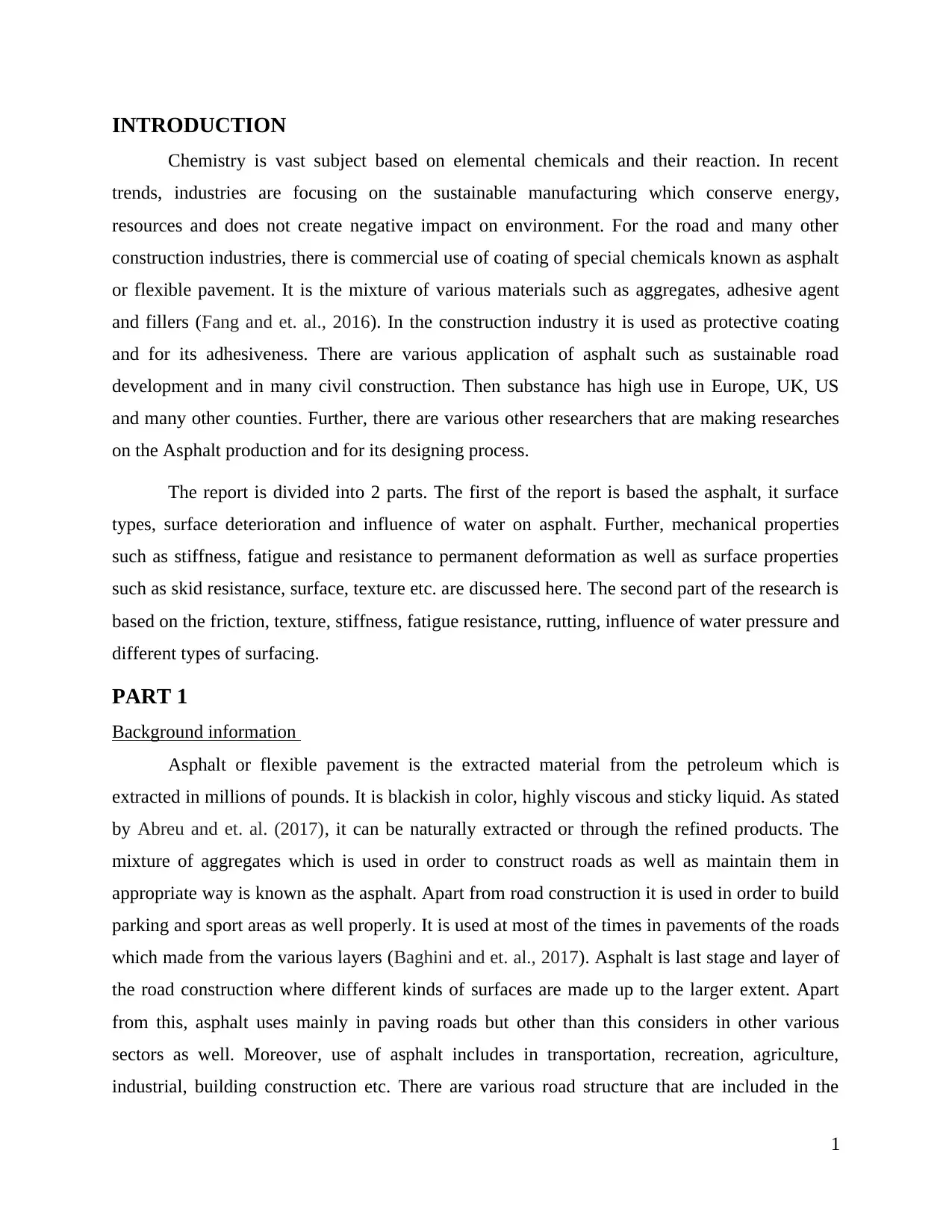
INTRODUCTION
Chemistry is vast subject based on elemental chemicals and their reaction. In recent
trends, industries are focusing on the sustainable manufacturing which conserve energy,
resources and does not create negative impact on environment. For the road and many other
construction industries, there is commercial use of coating of special chemicals known as asphalt
or flexible pavement. It is the mixture of various materials such as aggregates, adhesive agent
and fillers (Fang and et. al., 2016). In the construction industry it is used as protective coating
and for its adhesiveness. There are various application of asphalt such as sustainable road
development and in many civil construction. Then substance has high use in Europe, UK, US
and many other counties. Further, there are various other researchers that are making researches
on the Asphalt production and for its designing process.
The report is divided into 2 parts. The first of the report is based the asphalt, it surface
types, surface deterioration and influence of water on asphalt. Further, mechanical properties
such as stiffness, fatigue and resistance to permanent deformation as well as surface properties
such as skid resistance, surface, texture etc. are discussed here. The second part of the research is
based on the friction, texture, stiffness, fatigue resistance, rutting, influence of water pressure and
different types of surfacing.
PART 1
Background information
Asphalt or flexible pavement is the extracted material from the petroleum which is
extracted in millions of pounds. It is blackish in color, highly viscous and sticky liquid. As stated
by Abreu and et. al. (2017), it can be naturally extracted or through the refined products. The
mixture of aggregates which is used in order to construct roads as well as maintain them in
appropriate way is known as the asphalt. Apart from road construction it is used in order to build
parking and sport areas as well properly. It is used at most of the times in pavements of the roads
which made from the various layers (Baghini and et. al., 2017). Asphalt is last stage and layer of
the road construction where different kinds of surfaces are made up to the larger extent. Apart
from this, asphalt uses mainly in paving roads but other than this considers in other various
sectors as well. Moreover, use of asphalt includes in transportation, recreation, agriculture,
industrial, building construction etc. There are various road structure that are included in the
1
Chemistry is vast subject based on elemental chemicals and their reaction. In recent
trends, industries are focusing on the sustainable manufacturing which conserve energy,
resources and does not create negative impact on environment. For the road and many other
construction industries, there is commercial use of coating of special chemicals known as asphalt
or flexible pavement. It is the mixture of various materials such as aggregates, adhesive agent
and fillers (Fang and et. al., 2016). In the construction industry it is used as protective coating
and for its adhesiveness. There are various application of asphalt such as sustainable road
development and in many civil construction. Then substance has high use in Europe, UK, US
and many other counties. Further, there are various other researchers that are making researches
on the Asphalt production and for its designing process.
The report is divided into 2 parts. The first of the report is based the asphalt, it surface
types, surface deterioration and influence of water on asphalt. Further, mechanical properties
such as stiffness, fatigue and resistance to permanent deformation as well as surface properties
such as skid resistance, surface, texture etc. are discussed here. The second part of the research is
based on the friction, texture, stiffness, fatigue resistance, rutting, influence of water pressure and
different types of surfacing.
PART 1
Background information
Asphalt or flexible pavement is the extracted material from the petroleum which is
extracted in millions of pounds. It is blackish in color, highly viscous and sticky liquid. As stated
by Abreu and et. al. (2017), it can be naturally extracted or through the refined products. The
mixture of aggregates which is used in order to construct roads as well as maintain them in
appropriate way is known as the asphalt. Apart from road construction it is used in order to build
parking and sport areas as well properly. It is used at most of the times in pavements of the roads
which made from the various layers (Baghini and et. al., 2017). Asphalt is last stage and layer of
the road construction where different kinds of surfaces are made up to the larger extent. Apart
from this, asphalt uses mainly in paving roads but other than this considers in other various
sectors as well. Moreover, use of asphalt includes in transportation, recreation, agriculture,
industrial, building construction etc. There are various road structure that are included in the
1
⊘ This is a preview!⊘
Do you want full access?
Subscribe today to unlock all pages.

Trusted by 1+ million students worldwide
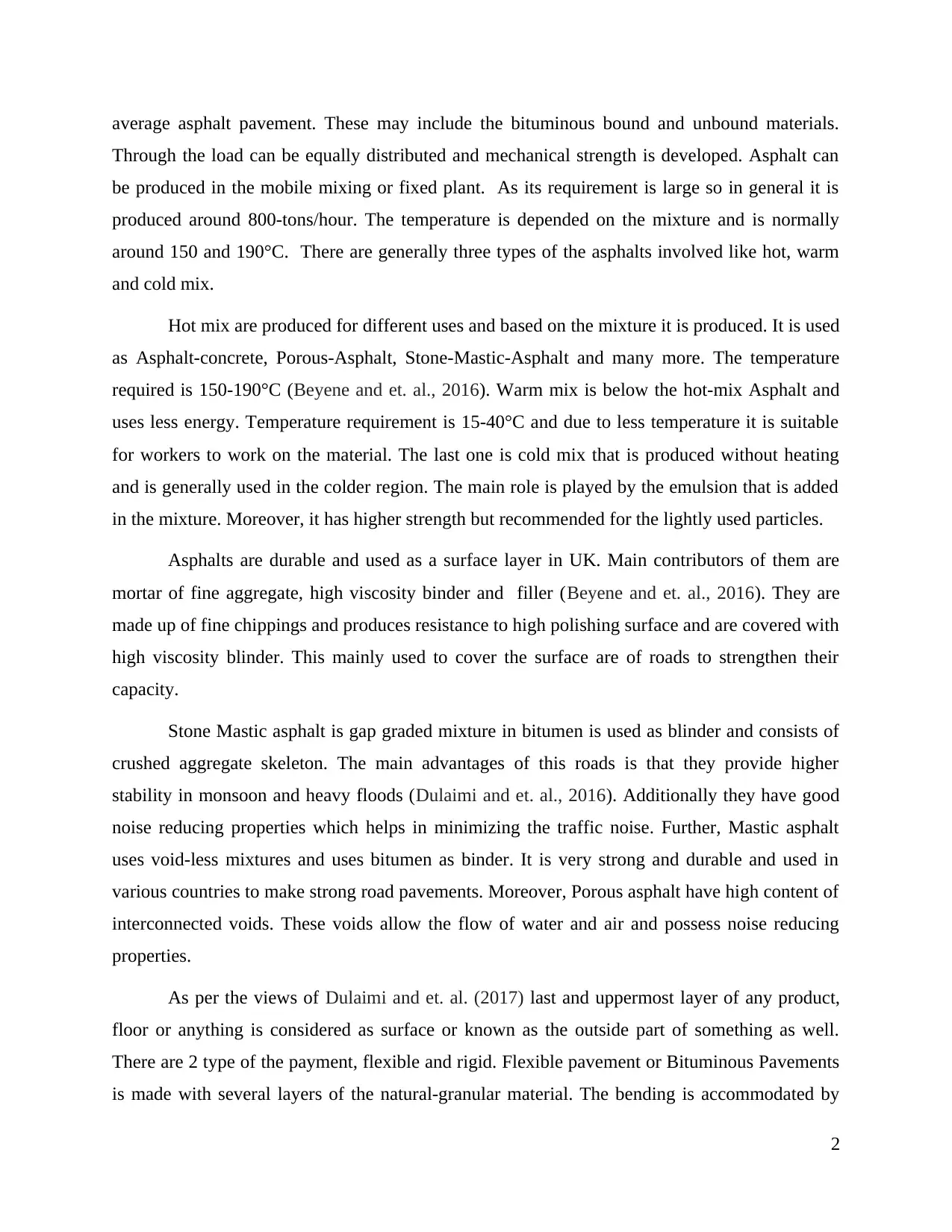
average asphalt pavement. These may include the bituminous bound and unbound materials.
Through the load can be equally distributed and mechanical strength is developed. Asphalt can
be produced in the mobile mixing or fixed plant. As its requirement is large so in general it is
produced around 800-tons/hour. The temperature is depended on the mixture and is normally
around 150 and 190°C. There are generally three types of the asphalts involved like hot, warm
and cold mix.
Hot mix are produced for different uses and based on the mixture it is produced. It is used
as Asphalt-concrete, Porous-Asphalt, Stone-Mastic-Asphalt and many more. The temperature
required is 150-190°C (Beyene and et. al., 2016). Warm mix is below the hot-mix Asphalt and
uses less energy. Temperature requirement is 15-40°C and due to less temperature it is suitable
for workers to work on the material. The last one is cold mix that is produced without heating
and is generally used in the colder region. The main role is played by the emulsion that is added
in the mixture. Moreover, it has higher strength but recommended for the lightly used particles.
Asphalts are durable and used as a surface layer in UK. Main contributors of them are
mortar of fine aggregate, high viscosity binder and filler (Beyene and et. al., 2016). They are
made up of fine chippings and produces resistance to high polishing surface and are covered with
high viscosity blinder. This mainly used to cover the surface are of roads to strengthen their
capacity.
Stone Mastic asphalt is gap graded mixture in bitumen is used as blinder and consists of
crushed aggregate skeleton. The main advantages of this roads is that they provide higher
stability in monsoon and heavy floods (Dulaimi and et. al., 2016). Additionally they have good
noise reducing properties which helps in minimizing the traffic noise. Further, Mastic asphalt
uses void-less mixtures and uses bitumen as binder. It is very strong and durable and used in
various countries to make strong road pavements. Moreover, Porous asphalt have high content of
interconnected voids. These voids allow the flow of water and air and possess noise reducing
properties.
As per the views of Dulaimi and et. al. (2017) last and uppermost layer of any product,
floor or anything is considered as surface or known as the outside part of something as well.
There are 2 type of the payment, flexible and rigid. Flexible pavement or Bituminous Pavements
is made with several layers of the natural-granular material. The bending is accommodated by
2
Through the load can be equally distributed and mechanical strength is developed. Asphalt can
be produced in the mobile mixing or fixed plant. As its requirement is large so in general it is
produced around 800-tons/hour. The temperature is depended on the mixture and is normally
around 150 and 190°C. There are generally three types of the asphalts involved like hot, warm
and cold mix.
Hot mix are produced for different uses and based on the mixture it is produced. It is used
as Asphalt-concrete, Porous-Asphalt, Stone-Mastic-Asphalt and many more. The temperature
required is 150-190°C (Beyene and et. al., 2016). Warm mix is below the hot-mix Asphalt and
uses less energy. Temperature requirement is 15-40°C and due to less temperature it is suitable
for workers to work on the material. The last one is cold mix that is produced without heating
and is generally used in the colder region. The main role is played by the emulsion that is added
in the mixture. Moreover, it has higher strength but recommended for the lightly used particles.
Asphalts are durable and used as a surface layer in UK. Main contributors of them are
mortar of fine aggregate, high viscosity binder and filler (Beyene and et. al., 2016). They are
made up of fine chippings and produces resistance to high polishing surface and are covered with
high viscosity blinder. This mainly used to cover the surface are of roads to strengthen their
capacity.
Stone Mastic asphalt is gap graded mixture in bitumen is used as blinder and consists of
crushed aggregate skeleton. The main advantages of this roads is that they provide higher
stability in monsoon and heavy floods (Dulaimi and et. al., 2016). Additionally they have good
noise reducing properties which helps in minimizing the traffic noise. Further, Mastic asphalt
uses void-less mixtures and uses bitumen as binder. It is very strong and durable and used in
various countries to make strong road pavements. Moreover, Porous asphalt have high content of
interconnected voids. These voids allow the flow of water and air and possess noise reducing
properties.
As per the views of Dulaimi and et. al. (2017) last and uppermost layer of any product,
floor or anything is considered as surface or known as the outside part of something as well.
There are 2 type of the payment, flexible and rigid. Flexible pavement or Bituminous Pavements
is made with several layers of the natural-granular material. The bending is accommodated by
2
Paraphrase This Document
Need a fresh take? Get an instant paraphrase of this document with our AI Paraphraser
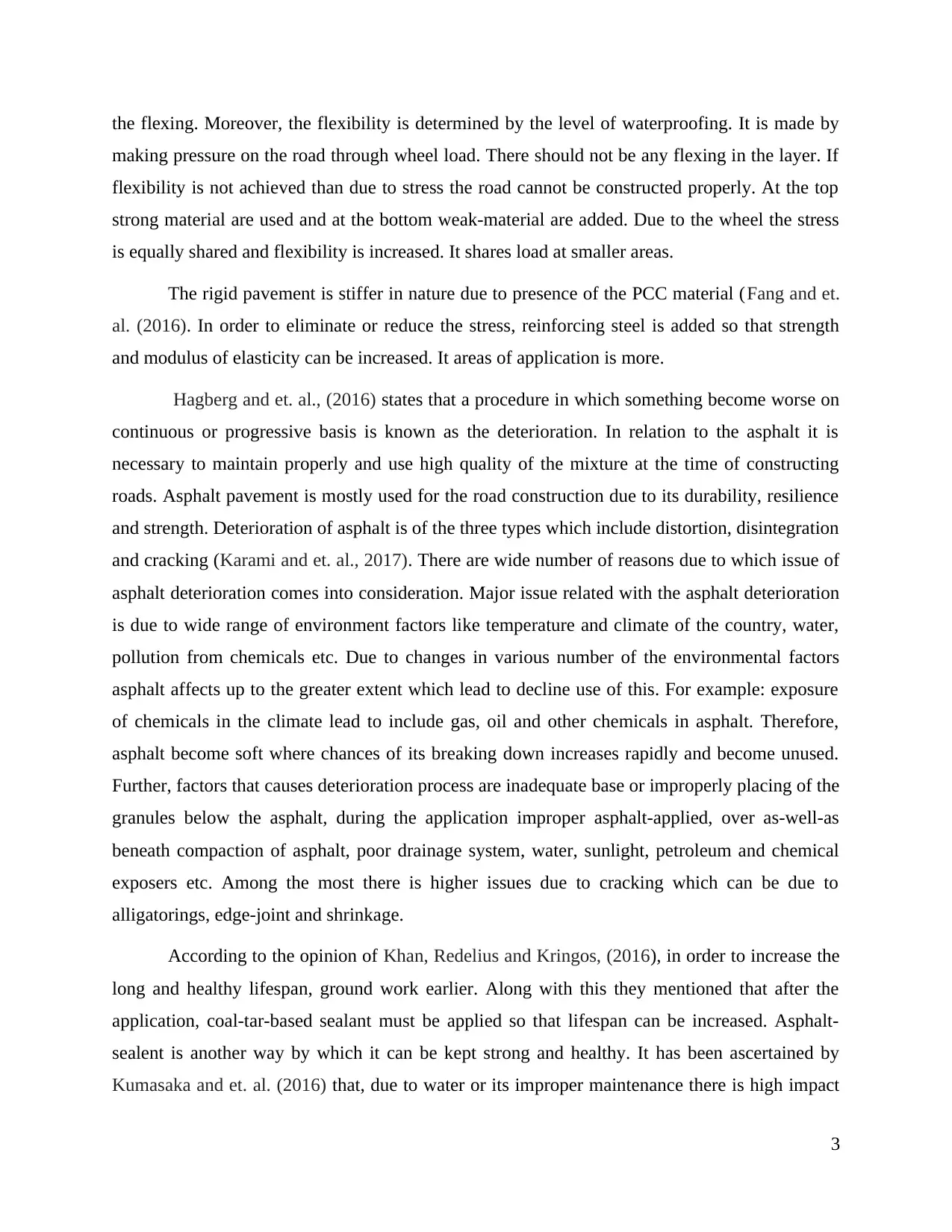
the flexing. Moreover, the flexibility is determined by the level of waterproofing. It is made by
making pressure on the road through wheel load. There should not be any flexing in the layer. If
flexibility is not achieved than due to stress the road cannot be constructed properly. At the top
strong material are used and at the bottom weak-material are added. Due to the wheel the stress
is equally shared and flexibility is increased. It shares load at smaller areas.
The rigid pavement is stiffer in nature due to presence of the PCC material (Fang and et.
al. (2016). In order to eliminate or reduce the stress, reinforcing steel is added so that strength
and modulus of elasticity can be increased. It areas of application is more.
Hagberg and et. al., (2016) states that a procedure in which something become worse on
continuous or progressive basis is known as the deterioration. In relation to the asphalt it is
necessary to maintain properly and use high quality of the mixture at the time of constructing
roads. Asphalt pavement is mostly used for the road construction due to its durability, resilience
and strength. Deterioration of asphalt is of the three types which include distortion, disintegration
and cracking (Karami and et. al., 2017). There are wide number of reasons due to which issue of
asphalt deterioration comes into consideration. Major issue related with the asphalt deterioration
is due to wide range of environment factors like temperature and climate of the country, water,
pollution from chemicals etc. Due to changes in various number of the environmental factors
asphalt affects up to the greater extent which lead to decline use of this. For example: exposure
of chemicals in the climate lead to include gas, oil and other chemicals in asphalt. Therefore,
asphalt become soft where chances of its breaking down increases rapidly and become unused.
Further, factors that causes deterioration process are inadequate base or improperly placing of the
granules below the asphalt, during the application improper asphalt-applied, over as-well-as
beneath compaction of asphalt, poor drainage system, water, sunlight, petroleum and chemical
exposers etc. Among the most there is higher issues due to cracking which can be due to
alligatorings, edge-joint and shrinkage.
According to the opinion of Khan, Redelius and Kringos, (2016), in order to increase the
long and healthy lifespan, ground work earlier. Along with this they mentioned that after the
application, coal-tar-based sealant must be applied so that lifespan can be increased. Asphalt-
sealent is another way by which it can be kept strong and healthy. It has been ascertained by
Kumasaka and et. al. (2016) that, due to water or its improper maintenance there is high impact
3
making pressure on the road through wheel load. There should not be any flexing in the layer. If
flexibility is not achieved than due to stress the road cannot be constructed properly. At the top
strong material are used and at the bottom weak-material are added. Due to the wheel the stress
is equally shared and flexibility is increased. It shares load at smaller areas.
The rigid pavement is stiffer in nature due to presence of the PCC material (Fang and et.
al. (2016). In order to eliminate or reduce the stress, reinforcing steel is added so that strength
and modulus of elasticity can be increased. It areas of application is more.
Hagberg and et. al., (2016) states that a procedure in which something become worse on
continuous or progressive basis is known as the deterioration. In relation to the asphalt it is
necessary to maintain properly and use high quality of the mixture at the time of constructing
roads. Asphalt pavement is mostly used for the road construction due to its durability, resilience
and strength. Deterioration of asphalt is of the three types which include distortion, disintegration
and cracking (Karami and et. al., 2017). There are wide number of reasons due to which issue of
asphalt deterioration comes into consideration. Major issue related with the asphalt deterioration
is due to wide range of environment factors like temperature and climate of the country, water,
pollution from chemicals etc. Due to changes in various number of the environmental factors
asphalt affects up to the greater extent which lead to decline use of this. For example: exposure
of chemicals in the climate lead to include gas, oil and other chemicals in asphalt. Therefore,
asphalt become soft where chances of its breaking down increases rapidly and become unused.
Further, factors that causes deterioration process are inadequate base or improperly placing of the
granules below the asphalt, during the application improper asphalt-applied, over as-well-as
beneath compaction of asphalt, poor drainage system, water, sunlight, petroleum and chemical
exposers etc. Among the most there is higher issues due to cracking which can be due to
alligatorings, edge-joint and shrinkage.
According to the opinion of Khan, Redelius and Kringos, (2016), in order to increase the
long and healthy lifespan, ground work earlier. Along with this they mentioned that after the
application, coal-tar-based sealant must be applied so that lifespan can be increased. Asphalt-
sealent is another way by which it can be kept strong and healthy. It has been ascertained by
Kumasaka and et. al. (2016) that, due to water or its improper maintenance there is high impact
3
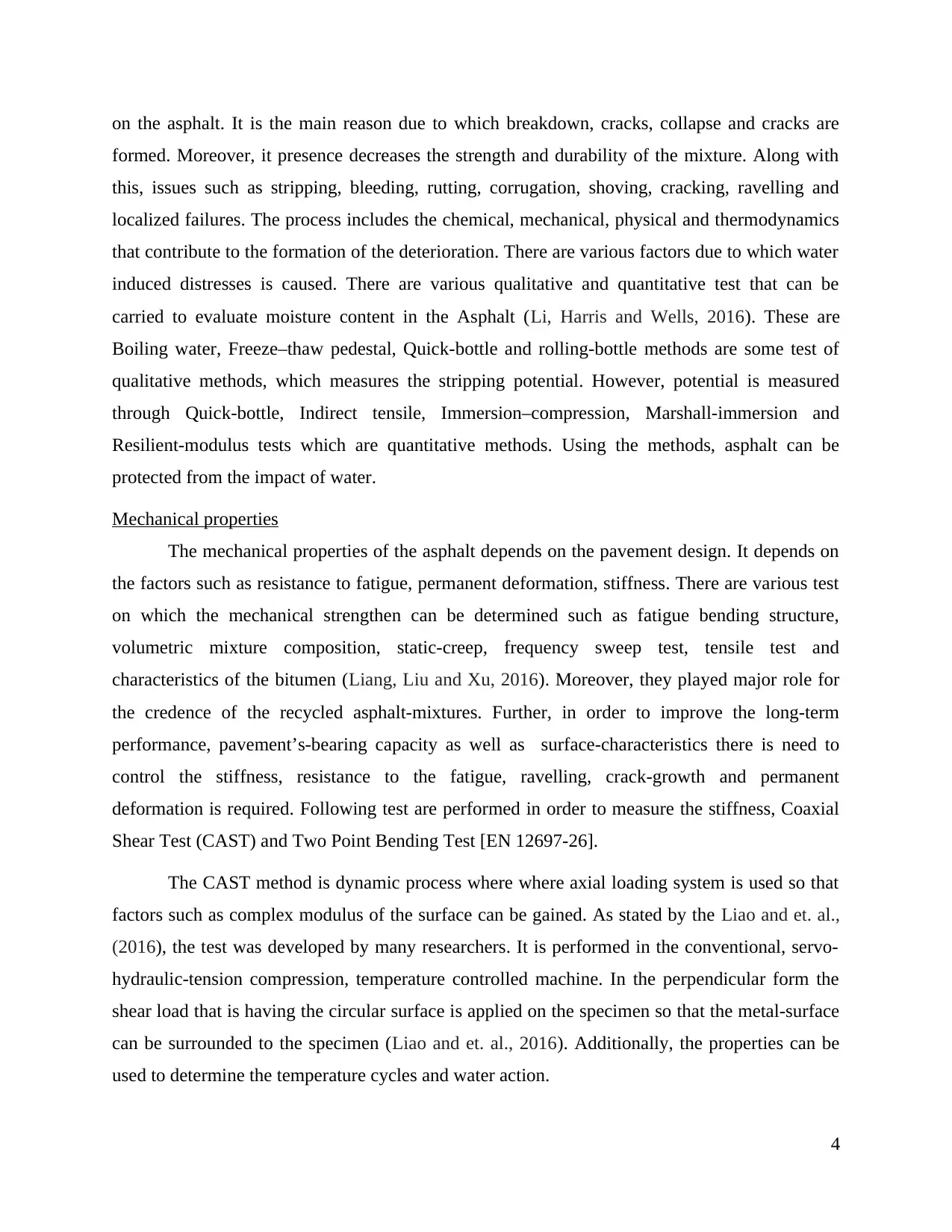
on the asphalt. It is the main reason due to which breakdown, cracks, collapse and cracks are
formed. Moreover, it presence decreases the strength and durability of the mixture. Along with
this, issues such as stripping, bleeding, rutting, corrugation, shoving, cracking, ravelling and
localized failures. The process includes the chemical, mechanical, physical and thermodynamics
that contribute to the formation of the deterioration. There are various factors due to which water
induced distresses is caused. There are various qualitative and quantitative test that can be
carried to evaluate moisture content in the Asphalt (Li, Harris and Wells, 2016). These are
Boiling water, Freeze–thaw pedestal, Quick-bottle and rolling-bottle methods are some test of
qualitative methods, which measures the stripping potential. However, potential is measured
through Quick-bottle, Indirect tensile, Immersion–compression, Marshall-immersion and
Resilient-modulus tests which are quantitative methods. Using the methods, asphalt can be
protected from the impact of water.
Mechanical properties
The mechanical properties of the asphalt depends on the pavement design. It depends on
the factors such as resistance to fatigue, permanent deformation, stiffness. There are various test
on which the mechanical strengthen can be determined such as fatigue bending structure,
volumetric mixture composition, static-creep, frequency sweep test, tensile test and
characteristics of the bitumen (Liang, Liu and Xu, 2016). Moreover, they played major role for
the credence of the recycled asphalt-mixtures. Further, in order to improve the long-term
performance, pavement’s-bearing capacity as well as surface-characteristics there is need to
control the stiffness, resistance to the fatigue, ravelling, crack-growth and permanent
deformation is required. Following test are performed in order to measure the stiffness, Coaxial
Shear Test (CAST) and Two Point Bending Test [EN 12697-26].
The CAST method is dynamic process where where axial loading system is used so that
factors such as complex modulus of the surface can be gained. As stated by the Liao and et. al.,
(2016), the test was developed by many researchers. It is performed in the conventional, servo-
hydraulic-tension compression, temperature controlled machine. In the perpendicular form the
shear load that is having the circular surface is applied on the specimen so that the metal-surface
can be surrounded to the specimen (Liao and et. al., 2016). Additionally, the properties can be
used to determine the temperature cycles and water action.
4
formed. Moreover, it presence decreases the strength and durability of the mixture. Along with
this, issues such as stripping, bleeding, rutting, corrugation, shoving, cracking, ravelling and
localized failures. The process includes the chemical, mechanical, physical and thermodynamics
that contribute to the formation of the deterioration. There are various factors due to which water
induced distresses is caused. There are various qualitative and quantitative test that can be
carried to evaluate moisture content in the Asphalt (Li, Harris and Wells, 2016). These are
Boiling water, Freeze–thaw pedestal, Quick-bottle and rolling-bottle methods are some test of
qualitative methods, which measures the stripping potential. However, potential is measured
through Quick-bottle, Indirect tensile, Immersion–compression, Marshall-immersion and
Resilient-modulus tests which are quantitative methods. Using the methods, asphalt can be
protected from the impact of water.
Mechanical properties
The mechanical properties of the asphalt depends on the pavement design. It depends on
the factors such as resistance to fatigue, permanent deformation, stiffness. There are various test
on which the mechanical strengthen can be determined such as fatigue bending structure,
volumetric mixture composition, static-creep, frequency sweep test, tensile test and
characteristics of the bitumen (Liang, Liu and Xu, 2016). Moreover, they played major role for
the credence of the recycled asphalt-mixtures. Further, in order to improve the long-term
performance, pavement’s-bearing capacity as well as surface-characteristics there is need to
control the stiffness, resistance to the fatigue, ravelling, crack-growth and permanent
deformation is required. Following test are performed in order to measure the stiffness, Coaxial
Shear Test (CAST) and Two Point Bending Test [EN 12697-26].
The CAST method is dynamic process where where axial loading system is used so that
factors such as complex modulus of the surface can be gained. As stated by the Liao and et. al.,
(2016), the test was developed by many researchers. It is performed in the conventional, servo-
hydraulic-tension compression, temperature controlled machine. In the perpendicular form the
shear load that is having the circular surface is applied on the specimen so that the metal-surface
can be surrounded to the specimen (Liao and et. al., 2016). Additionally, the properties can be
used to determine the temperature cycles and water action.
4
⊘ This is a preview!⊘
Do you want full access?
Subscribe today to unlock all pages.

Trusted by 1+ million students worldwide
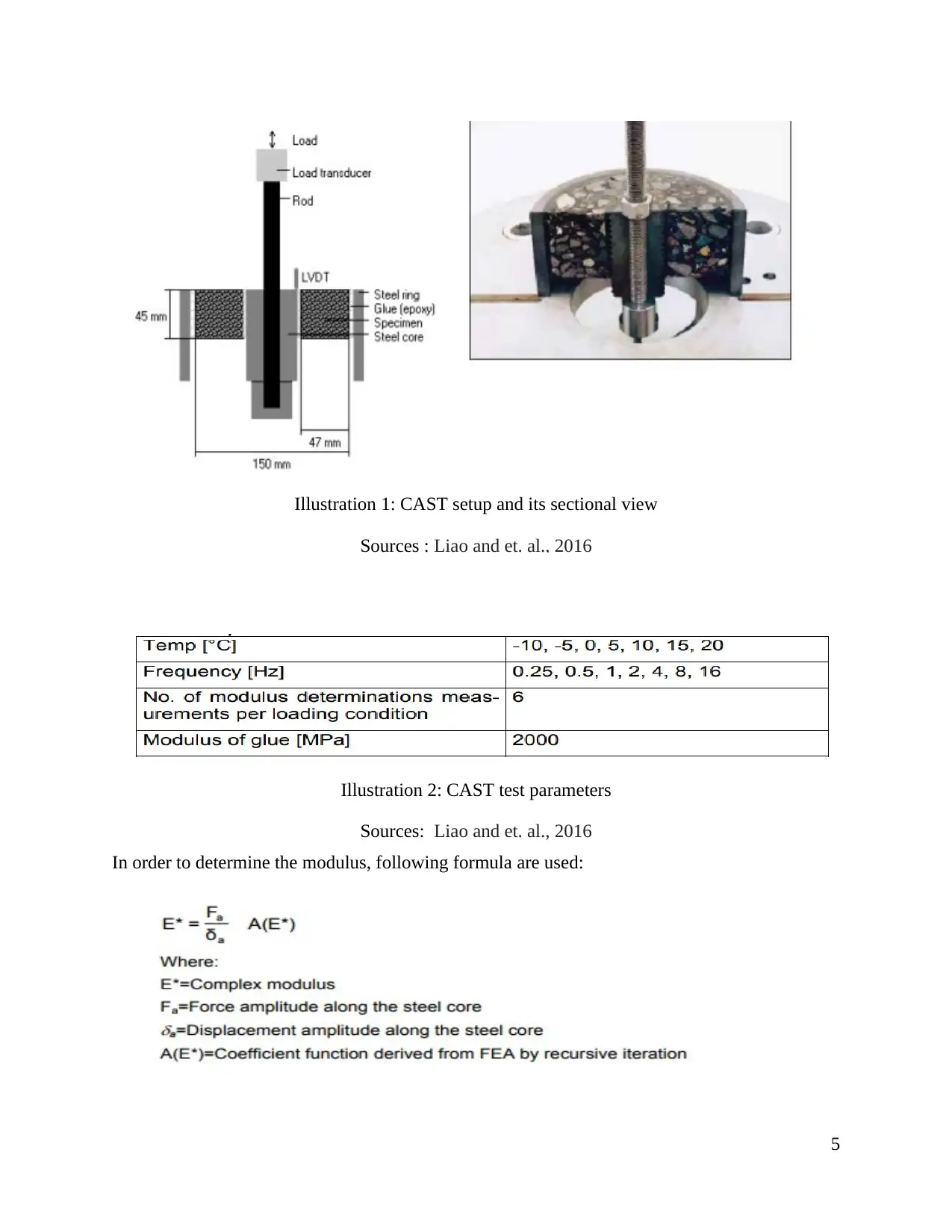
In order to determine the modulus, following formula are used:
5
Illustration 1: CAST setup and its sectional view
Sources : Liao and et. al., 2016
Illustration 2: CAST test parameters
Sources: Liao and et. al., 2016
5
Illustration 1: CAST setup and its sectional view
Sources : Liao and et. al., 2016
Illustration 2: CAST test parameters
Sources: Liao and et. al., 2016
Paraphrase This Document
Need a fresh take? Get an instant paraphrase of this document with our AI Paraphraser
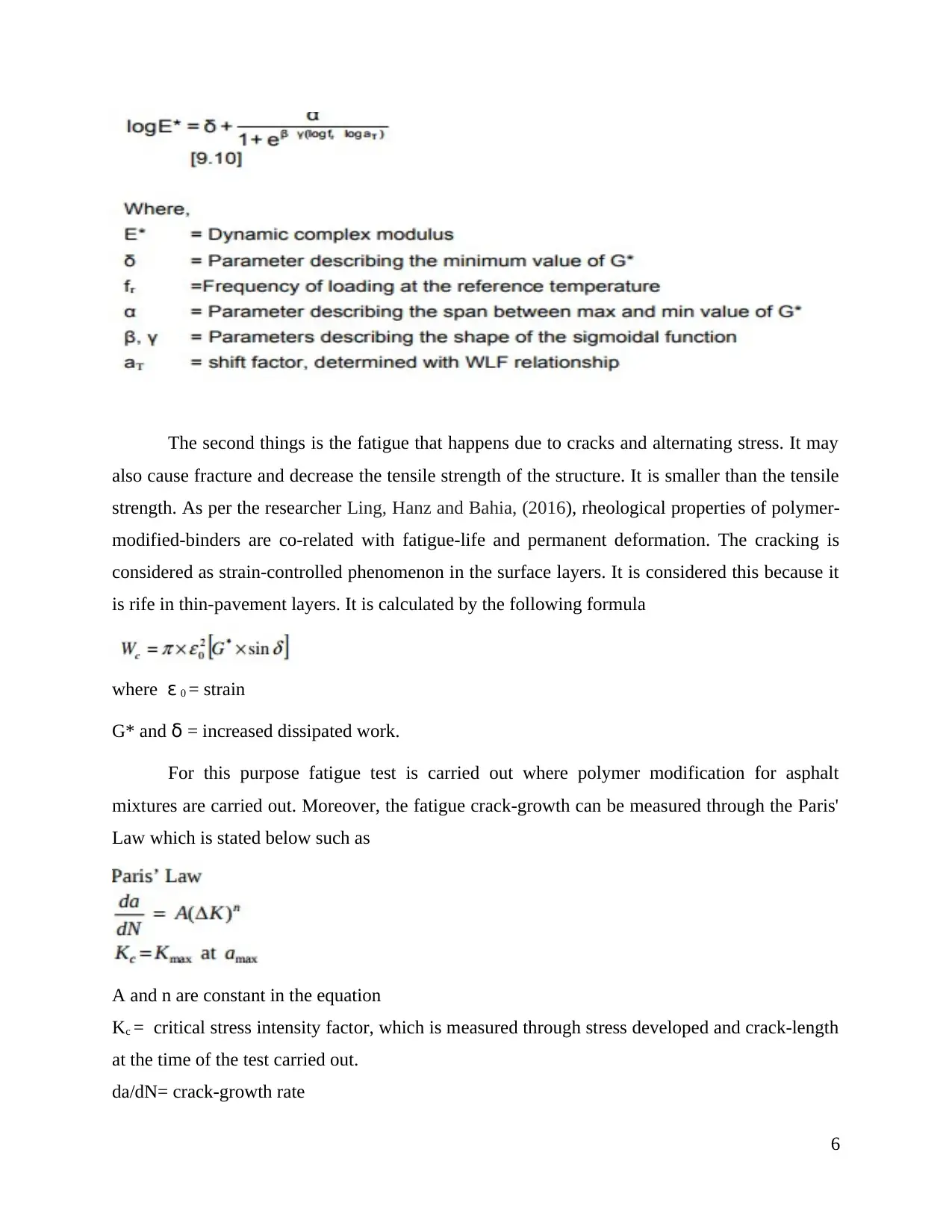
The second things is the fatigue that happens due to cracks and alternating stress. It may
also cause fracture and decrease the tensile strength of the structure. It is smaller than the tensile
strength. As per the researcher Ling, Hanz and Bahia, (2016), rheological properties of polymer-
modified-binders are co-related with fatigue-life and permanent deformation. The cracking is
considered as strain-controlled phenomenon in the surface layers. It is considered this because it
is rife in thin-pavement layers. It is calculated by the following formula
where ε 0 = strain
G* and δ = increased dissipated work.
For this purpose fatigue test is carried out where polymer modification for asphalt
mixtures are carried out. Moreover, the fatigue crack-growth can be measured through the Paris'
Law which is stated below such as
A and n are constant in the equation
Kc = critical stress intensity factor, which is measured through stress developed and crack-length
at the time of the test carried out.
da/dN= crack-growth rate
6
also cause fracture and decrease the tensile strength of the structure. It is smaller than the tensile
strength. As per the researcher Ling, Hanz and Bahia, (2016), rheological properties of polymer-
modified-binders are co-related with fatigue-life and permanent deformation. The cracking is
considered as strain-controlled phenomenon in the surface layers. It is considered this because it
is rife in thin-pavement layers. It is calculated by the following formula
where ε 0 = strain
G* and δ = increased dissipated work.
For this purpose fatigue test is carried out where polymer modification for asphalt
mixtures are carried out. Moreover, the fatigue crack-growth can be measured through the Paris'
Law which is stated below such as
A and n are constant in the equation
Kc = critical stress intensity factor, which is measured through stress developed and crack-length
at the time of the test carried out.
da/dN= crack-growth rate
6
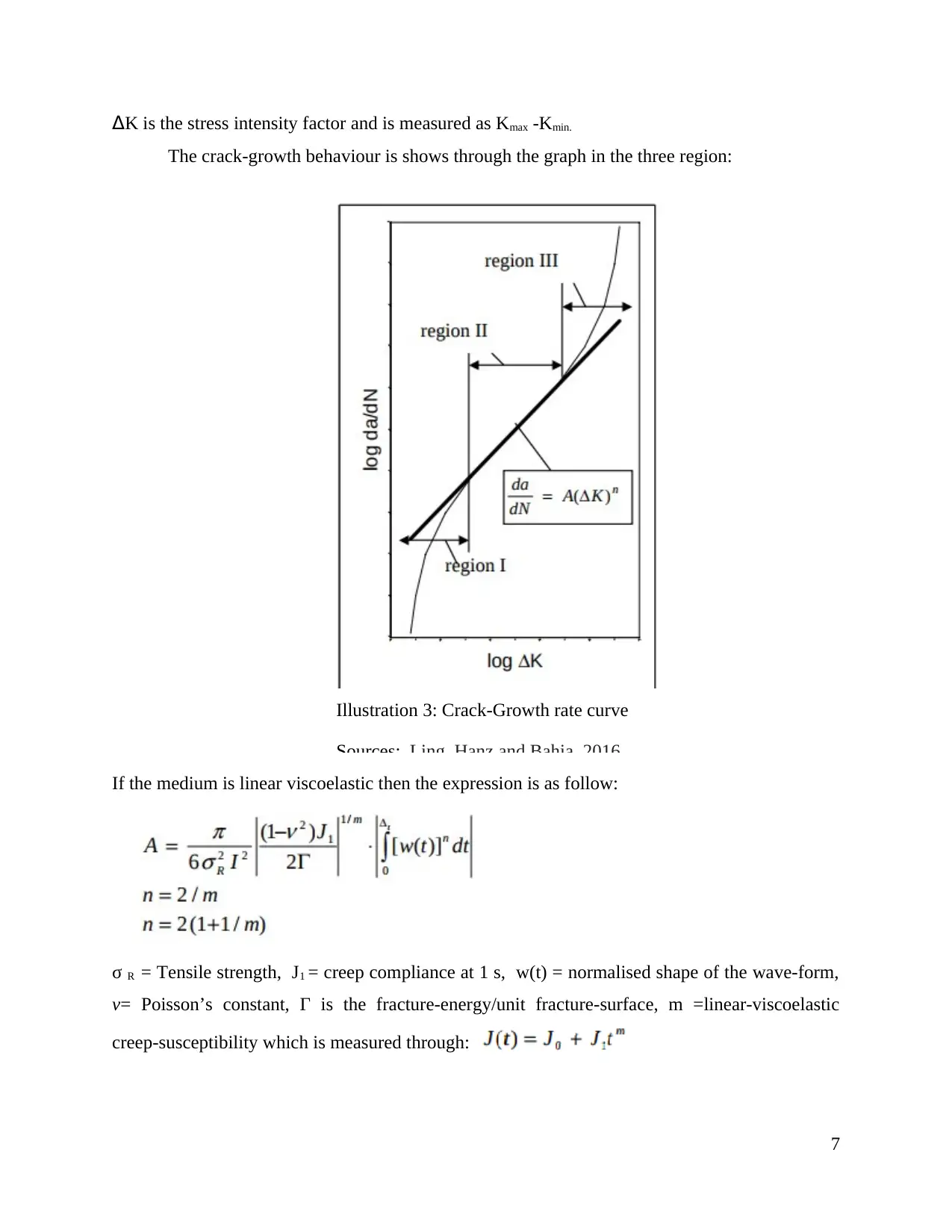
ΔK is the stress intensity factor and is measured as Kmax -Kmin.
The crack-growth behaviour is shows through the graph in the three region:
Illustration 3: Crack-Growth rate curve
Sources: Ling, Hanz and Bahia, 2016
If the medium is linear viscoelastic then the expression is as follow:
σ R = Tensile strength, J1 = creep compliance at 1 s, w(t) = normalised shape of the wave-form,
v= Poisson’s constant, Γ is the fracture-energy/unit fracture-surface, m =linear-viscoelastic
creep-susceptibility which is measured through:
7
The crack-growth behaviour is shows through the graph in the three region:
Illustration 3: Crack-Growth rate curve
Sources: Ling, Hanz and Bahia, 2016
If the medium is linear viscoelastic then the expression is as follow:
σ R = Tensile strength, J1 = creep compliance at 1 s, w(t) = normalised shape of the wave-form,
v= Poisson’s constant, Γ is the fracture-energy/unit fracture-surface, m =linear-viscoelastic
creep-susceptibility which is measured through:
7
⊘ This is a preview!⊘
Do you want full access?
Subscribe today to unlock all pages.

Trusted by 1+ million students worldwide
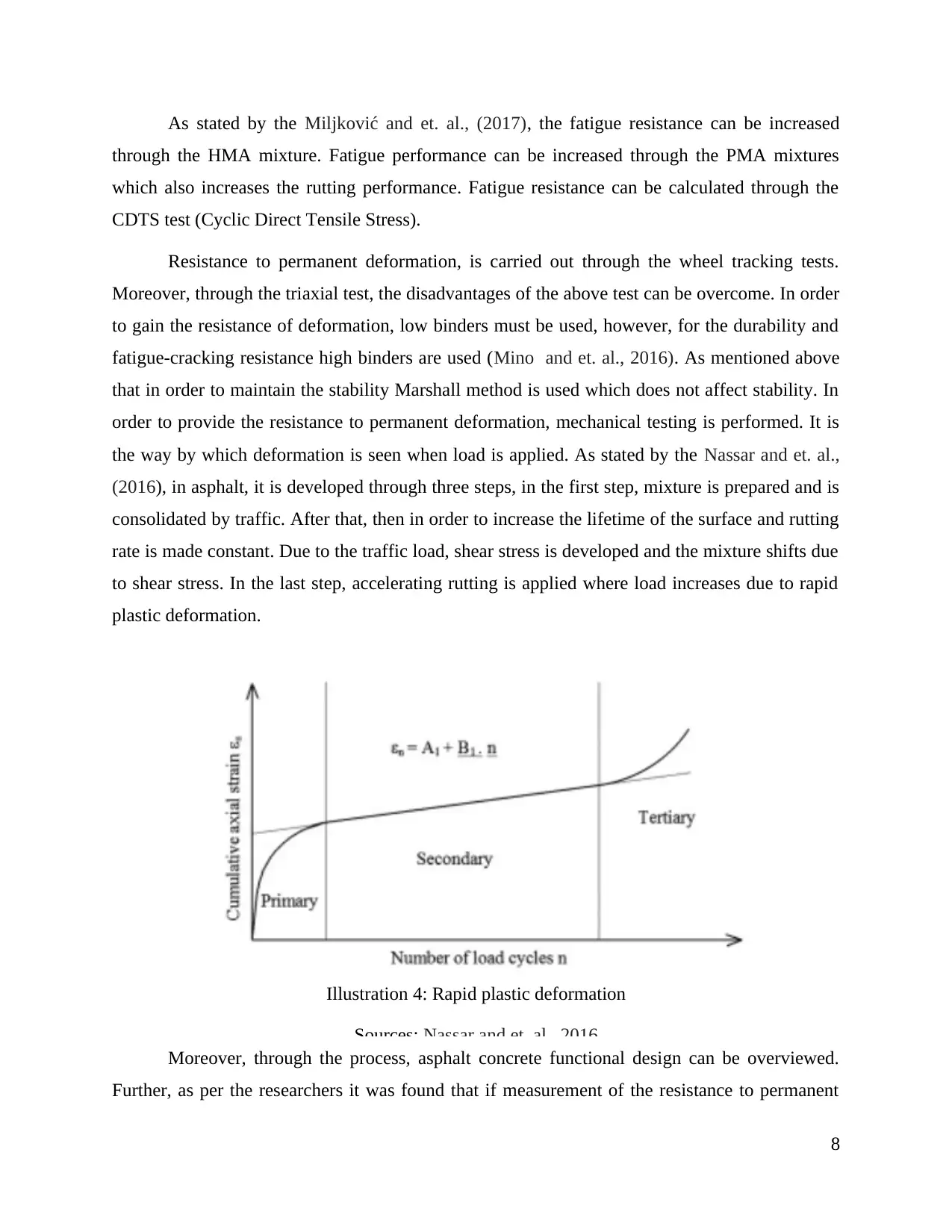
As stated by the Miljković and et. al., (2017), the fatigue resistance can be increased
through the HMA mixture. Fatigue performance can be increased through the PMA mixtures
which also increases the rutting performance. Fatigue resistance can be calculated through the
CDTS test (Cyclic Direct Tensile Stress).
Resistance to permanent deformation, is carried out through the wheel tracking tests.
Moreover, through the triaxial test, the disadvantages of the above test can be overcome. In order
to gain the resistance of deformation, low binders must be used, however, for the durability and
fatigue-cracking resistance high binders are used (Mino and et. al., 2016). As mentioned above
that in order to maintain the stability Marshall method is used which does not affect stability. In
order to provide the resistance to permanent deformation, mechanical testing is performed. It is
the way by which deformation is seen when load is applied. As stated by the Nassar and et. al.,
(2016), in asphalt, it is developed through three steps, in the first step, mixture is prepared and is
consolidated by traffic. After that, then in order to increase the lifetime of the surface and rutting
rate is made constant. Due to the traffic load, shear stress is developed and the mixture shifts due
to shear stress. In the last step, accelerating rutting is applied where load increases due to rapid
plastic deformation.
Moreover, through the process, asphalt concrete functional design can be overviewed.
Further, as per the researchers it was found that if measurement of the resistance to permanent
8
Illustration 4: Rapid plastic deformation
Sources: Nassar and et. al., 2016
through the HMA mixture. Fatigue performance can be increased through the PMA mixtures
which also increases the rutting performance. Fatigue resistance can be calculated through the
CDTS test (Cyclic Direct Tensile Stress).
Resistance to permanent deformation, is carried out through the wheel tracking tests.
Moreover, through the triaxial test, the disadvantages of the above test can be overcome. In order
to gain the resistance of deformation, low binders must be used, however, for the durability and
fatigue-cracking resistance high binders are used (Mino and et. al., 2016). As mentioned above
that in order to maintain the stability Marshall method is used which does not affect stability. In
order to provide the resistance to permanent deformation, mechanical testing is performed. It is
the way by which deformation is seen when load is applied. As stated by the Nassar and et. al.,
(2016), in asphalt, it is developed through three steps, in the first step, mixture is prepared and is
consolidated by traffic. After that, then in order to increase the lifetime of the surface and rutting
rate is made constant. Due to the traffic load, shear stress is developed and the mixture shifts due
to shear stress. In the last step, accelerating rutting is applied where load increases due to rapid
plastic deformation.
Moreover, through the process, asphalt concrete functional design can be overviewed.
Further, as per the researchers it was found that if measurement of the resistance to permanent
8
Illustration 4: Rapid plastic deformation
Sources: Nassar and et. al., 2016
Paraphrase This Document
Need a fresh take? Get an instant paraphrase of this document with our AI Paraphraser
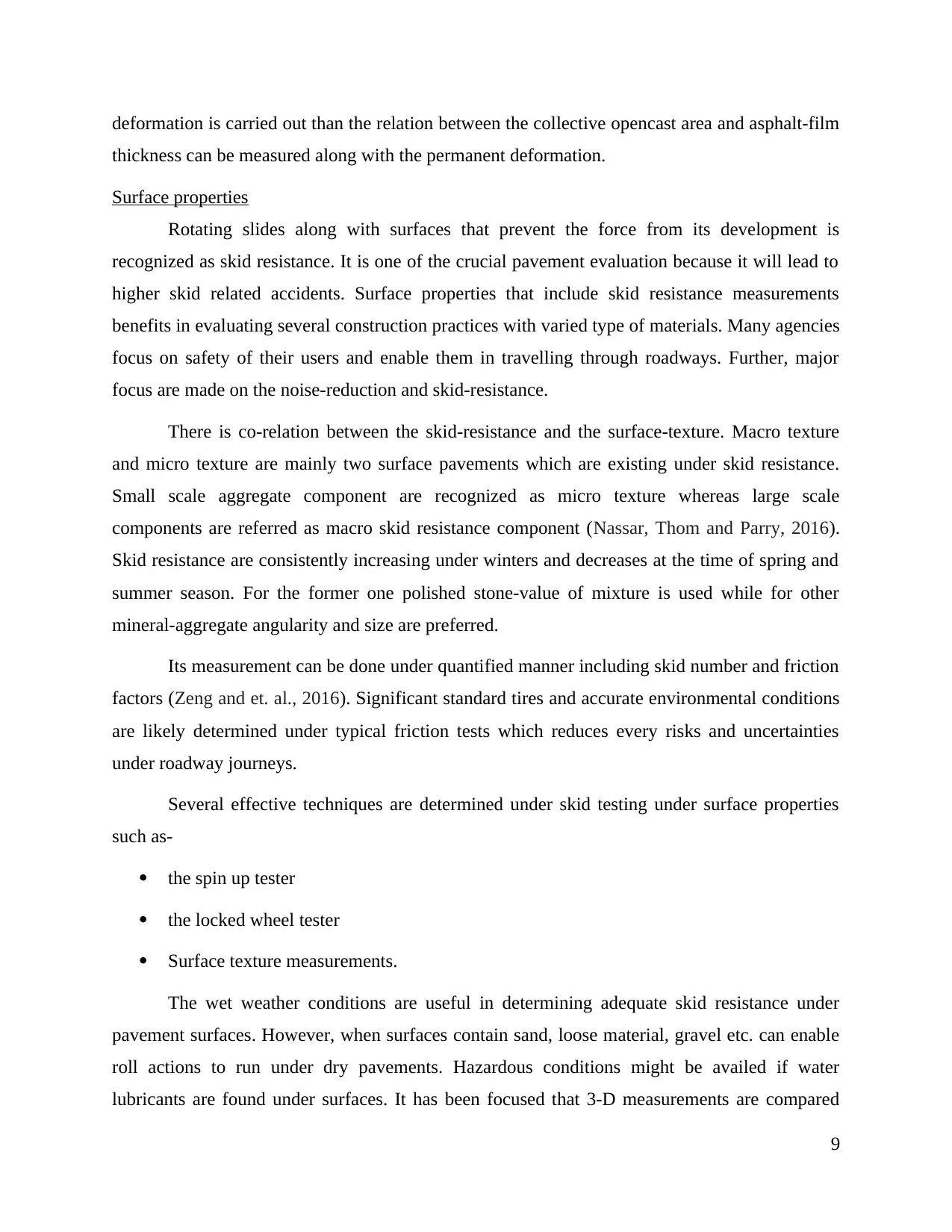
deformation is carried out than the relation between the collective opencast area and asphalt-film
thickness can be measured along with the permanent deformation.
Surface properties
Rotating slides along with surfaces that prevent the force from its development is
recognized as skid resistance. It is one of the crucial pavement evaluation because it will lead to
higher skid related accidents. Surface properties that include skid resistance measurements
benefits in evaluating several construction practices with varied type of materials. Many agencies
focus on safety of their users and enable them in travelling through roadways. Further, major
focus are made on the noise-reduction and skid-resistance.
There is co-relation between the skid-resistance and the surface-texture. Macro texture
and micro texture are mainly two surface pavements which are existing under skid resistance.
Small scale aggregate component are recognized as micro texture whereas large scale
components are referred as macro skid resistance component (Nassar, Thom and Parry, 2016).
Skid resistance are consistently increasing under winters and decreases at the time of spring and
summer season. For the former one polished stone-value of mixture is used while for other
mineral-aggregate angularity and size are preferred.
Its measurement can be done under quantified manner including skid number and friction
factors (Zeng and et. al., 2016). Significant standard tires and accurate environmental conditions
are likely determined under typical friction tests which reduces every risks and uncertainties
under roadway journeys.
Several effective techniques are determined under skid testing under surface properties
such as-
the spin up tester
the locked wheel tester
Surface texture measurements.
The wet weather conditions are useful in determining adequate skid resistance under
pavement surfaces. However, when surfaces contain sand, loose material, gravel etc. can enable
roll actions to run under dry pavements. Hazardous conditions might be availed if water
lubricants are found under surfaces. It has been focused that 3-D measurements are compared
9
thickness can be measured along with the permanent deformation.
Surface properties
Rotating slides along with surfaces that prevent the force from its development is
recognized as skid resistance. It is one of the crucial pavement evaluation because it will lead to
higher skid related accidents. Surface properties that include skid resistance measurements
benefits in evaluating several construction practices with varied type of materials. Many agencies
focus on safety of their users and enable them in travelling through roadways. Further, major
focus are made on the noise-reduction and skid-resistance.
There is co-relation between the skid-resistance and the surface-texture. Macro texture
and micro texture are mainly two surface pavements which are existing under skid resistance.
Small scale aggregate component are recognized as micro texture whereas large scale
components are referred as macro skid resistance component (Nassar, Thom and Parry, 2016).
Skid resistance are consistently increasing under winters and decreases at the time of spring and
summer season. For the former one polished stone-value of mixture is used while for other
mineral-aggregate angularity and size are preferred.
Its measurement can be done under quantified manner including skid number and friction
factors (Zeng and et. al., 2016). Significant standard tires and accurate environmental conditions
are likely determined under typical friction tests which reduces every risks and uncertainties
under roadway journeys.
Several effective techniques are determined under skid testing under surface properties
such as-
the spin up tester
the locked wheel tester
Surface texture measurements.
The wet weather conditions are useful in determining adequate skid resistance under
pavement surfaces. However, when surfaces contain sand, loose material, gravel etc. can enable
roll actions to run under dry pavements. Hazardous conditions might be availed if water
lubricants are found under surfaces. It has been focused that 3-D measurements are compared
9
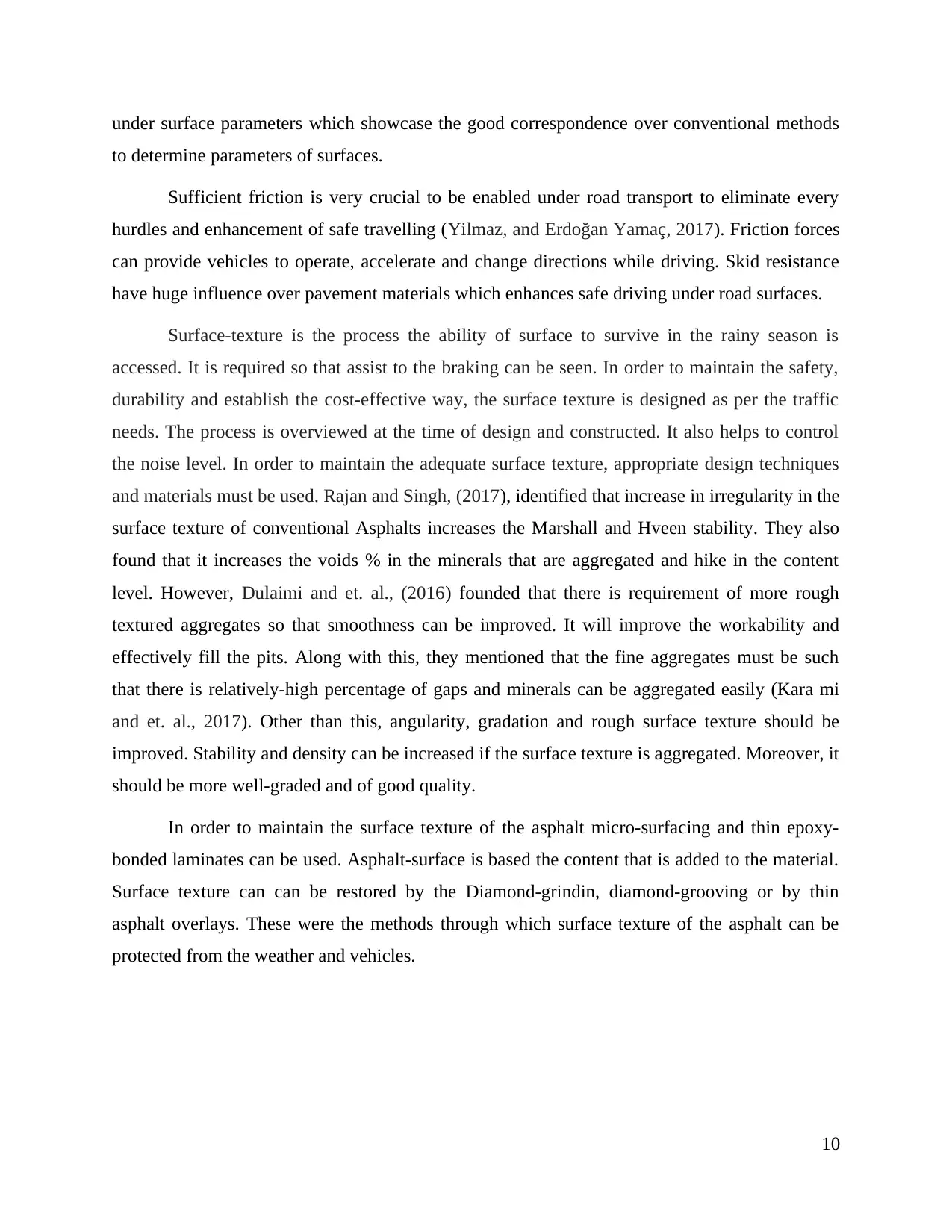
under surface parameters which showcase the good correspondence over conventional methods
to determine parameters of surfaces.
Sufficient friction is very crucial to be enabled under road transport to eliminate every
hurdles and enhancement of safe travelling (Yilmaz, and Erdoğan Yamaç, 2017). Friction forces
can provide vehicles to operate, accelerate and change directions while driving. Skid resistance
have huge influence over pavement materials which enhances safe driving under road surfaces.
Surface-texture is the process the ability of surface to survive in the rainy season is
accessed. It is required so that assist to the braking can be seen. In order to maintain the safety,
durability and establish the cost-effective way, the surface texture is designed as per the traffic
needs. The process is overviewed at the time of design and constructed. It also helps to control
the noise level. In order to maintain the adequate surface texture, appropriate design techniques
and materials must be used. Rajan and Singh, (2017), identified that increase in irregularity in the
surface texture of conventional Asphalts increases the Marshall and Hveen stability. They also
found that it increases the voids % in the minerals that are aggregated and hike in the content
level. However, Dulaimi and et. al., (2016) founded that there is requirement of more rough
textured aggregates so that smoothness can be improved. It will improve the workability and
effectively fill the pits. Along with this, they mentioned that the fine aggregates must be such
that there is relatively-high percentage of gaps and minerals can be aggregated easily (Kara mi
and et. al., 2017). Other than this, angularity, gradation and rough surface texture should be
improved. Stability and density can be increased if the surface texture is aggregated. Moreover, it
should be more well-graded and of good quality.
In order to maintain the surface texture of the asphalt micro-surfacing and thin epoxy-
bonded laminates can be used. Asphalt-surface is based the content that is added to the material.
Surface texture can can be restored by the Diamond-grindin, diamond-grooving or by thin
asphalt overlays. These were the methods through which surface texture of the asphalt can be
protected from the weather and vehicles.
10
to determine parameters of surfaces.
Sufficient friction is very crucial to be enabled under road transport to eliminate every
hurdles and enhancement of safe travelling (Yilmaz, and Erdoğan Yamaç, 2017). Friction forces
can provide vehicles to operate, accelerate and change directions while driving. Skid resistance
have huge influence over pavement materials which enhances safe driving under road surfaces.
Surface-texture is the process the ability of surface to survive in the rainy season is
accessed. It is required so that assist to the braking can be seen. In order to maintain the safety,
durability and establish the cost-effective way, the surface texture is designed as per the traffic
needs. The process is overviewed at the time of design and constructed. It also helps to control
the noise level. In order to maintain the adequate surface texture, appropriate design techniques
and materials must be used. Rajan and Singh, (2017), identified that increase in irregularity in the
surface texture of conventional Asphalts increases the Marshall and Hveen stability. They also
found that it increases the voids % in the minerals that are aggregated and hike in the content
level. However, Dulaimi and et. al., (2016) founded that there is requirement of more rough
textured aggregates so that smoothness can be improved. It will improve the workability and
effectively fill the pits. Along with this, they mentioned that the fine aggregates must be such
that there is relatively-high percentage of gaps and minerals can be aggregated easily (Kara mi
and et. al., 2017). Other than this, angularity, gradation and rough surface texture should be
improved. Stability and density can be increased if the surface texture is aggregated. Moreover, it
should be more well-graded and of good quality.
In order to maintain the surface texture of the asphalt micro-surfacing and thin epoxy-
bonded laminates can be used. Asphalt-surface is based the content that is added to the material.
Surface texture can can be restored by the Diamond-grindin, diamond-grooving or by thin
asphalt overlays. These were the methods through which surface texture of the asphalt can be
protected from the weather and vehicles.
10
⊘ This is a preview!⊘
Do you want full access?
Subscribe today to unlock all pages.

Trusted by 1+ million students worldwide
1 out of 19
Your All-in-One AI-Powered Toolkit for Academic Success.
+13062052269
info@desklib.com
Available 24*7 on WhatsApp / Email
![[object Object]](/_next/static/media/star-bottom.7253800d.svg)
Unlock your academic potential
Copyright © 2020–2025 A2Z Services. All Rights Reserved. Developed and managed by ZUCOL.
